In late November, Phillip and I figured the Trap Dike on Mt. Colden would have climbable ice on it. I’ve also spent a lot of time in the area, and this region of the Adirondacks is spectacular. Failure or not, it would be a fun outing.
We would be approaching from the South, and there are some great campsites on the south end of Lake Colden. It’s only a mile or two from the start of the dike and we would make that our base camp. The approach to those campsites is a mere 6 miles and 1,200 feet of gain on a moderately rugged trail. Compared to the ruggedness of the trails in the Northeast — especially the Adirondacks — this is a cakewalk. So, we decided to do it as a three-night outing, and backpack in an excessive amount of “glamping” stuff.
I packed two pairs of boots; two backpacks; a whole cheesecake; pasta and sauce; onions, beans and rice; a bear canister; and more luxuries. Phillip was similarly burdened. With such an easy approach, there’s no reason not to bring so much weight. At least, that’s how I justified it.
Due to class schedules and the long drive from Boston, we pulled into the trailhead at 11:00 p.m. We hoofed our 60-pound packs and started hiking.
The first quarter-mile was cruiser, and we laughed and joked the entire way about how fast we’d arrive. We jinxed ourselves talking about that, and everything would begin to turn.
Predicting conditions in the shoulder season is never easy, and we were way off on this one. There had been lots of rain, some snow, and plenty of low temperatures recently — which is why we thought the ice would be good in the Trap Dike. But, it seems that the trail is what got hit the most.
After a quarter-mile, deep water and mud covered the entire trail, with a thin layer of new ice on top of it all. With every step we’d take, we wouldn’t know if the ice would shatter or if it would hold. Every few minutes were punctuated by curses as we broke through the ice.
To avoid the thin ice, we would “rock-hop” over the tops of boulders and rocks. These acrobatics were strenuous with our burdened backpacks. To add to the matter, verglas covered most of these rocks. Even with microspikes, it wasn’t easy.
Phillip also discovered his boots weren’t waterproof anymore. The zipper had been acting up. With every plunge, freezing cold water would seep in, chilling his toes. He assured me it would be fine though. He had a -20 degree sleeping bag that would warm them right up once we got to camp.
11 p.m. rolled into midnight, and midnight rolled into 1 a.m. The going got even tougher, with a thin layer of snow now covering the verglassed rocks and the thin ice. This nonsense made me regret carrying a whole cheesecake in our pack, but a mile from the campsite, we ate a slice. That brought our energy back.
Cheesecake-fueled, we hiked the last strenuous mile to camp. There was no one here, of course, the Adirondacks are pretty empty once the snow begins to fall.
We pitched our tent, and at 3:30 a.m., finally went to sleep.
We woke up around 10 a.m., an ungodly hour for an alpine climb. We were that exhausted. With sunset 6 hours away, we wouldn’t be able to climb the technical, likely thin ice to the top of Mt. Colden and back. We resigned ourselves to scouting it, maybe climbing a few pitches, and then returning early tomorrow to send it.
The approach to the dike was similarly miserable. Thin ice over deep water and difficult rock-hopping. Some spots even had “exposure,” where if you slipped on verglassed rock, you’d plunge into Lake Colden. It was a lot of stuff, but looking back, it was quite fun. There’s nothing like difficult conditions to suffer through.
After hiking around Lake Colden, we reached Avalanche Lake. Some bushwhacking from there brought us to the base of the dike. There was ice, but of variable condition. The portion of the dike we could see had visible ice, but there was flowing water we didn’t like.
The cliffs of Avalanche Mountain across the lake had thin curtains of ice covering the cliffs. When it’s in, these go at WI5 and WI6. As the sun hit this ice, we saw several curtains break apart and collapse on the rock in a shower of ice shards. Ominous, to say the least.
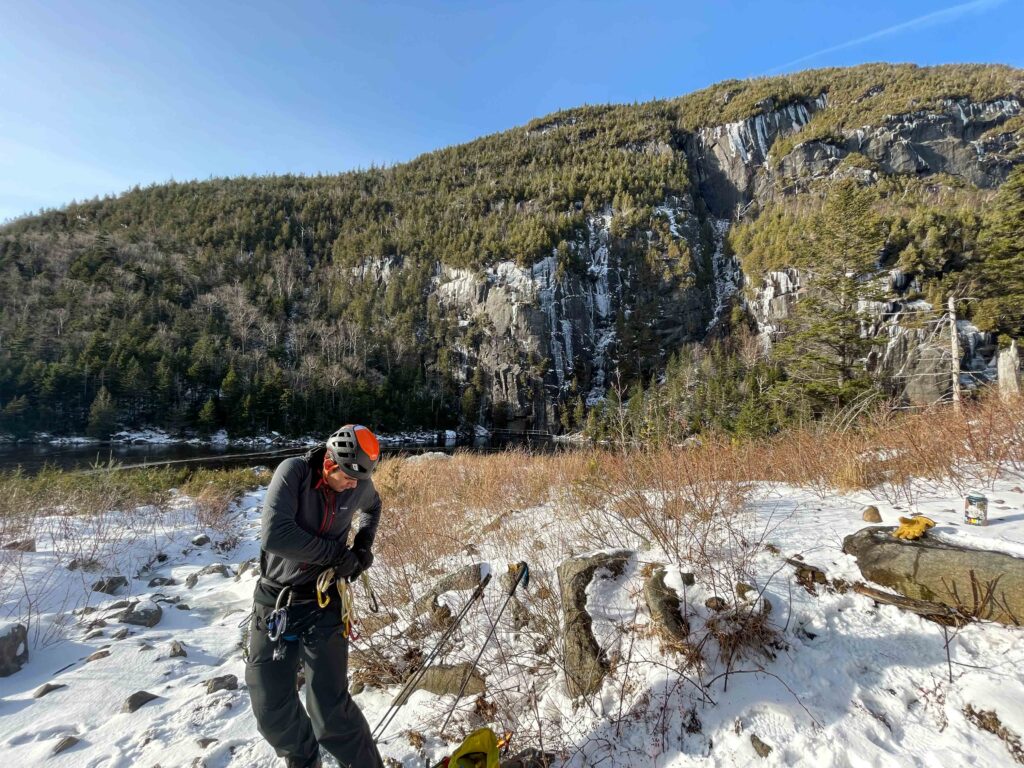
After racking up and switching to ice tools, we entered the dike. We scrambled ice-covered rocks and blocks, dulling our crampons and tools. We climbed up a few ledges but didn’t see any climbable ice. There was a good amount of water-ice forming to our left, but it was thin and saturated. Water was flowing underneath as well. The dike wasn’t remotely in.
Down-climbing was out of the question, and so we decided to rappel. There were no blocks to tie-off, nor good ice to V-thread. We ended up hammering in two pitons in a shallow crack to bail on.

Being the heaviest, I’d rappel first, but with a cam to back me up. It has pros and cons. I get to have a backup, but I’m also the “guinea pig” for testing the anchor.
As I rapped, most of the ice broke as I stepped on it. Sometimes my boot would break through and get caught in the icy current. Never up to my ankle, thankfully.
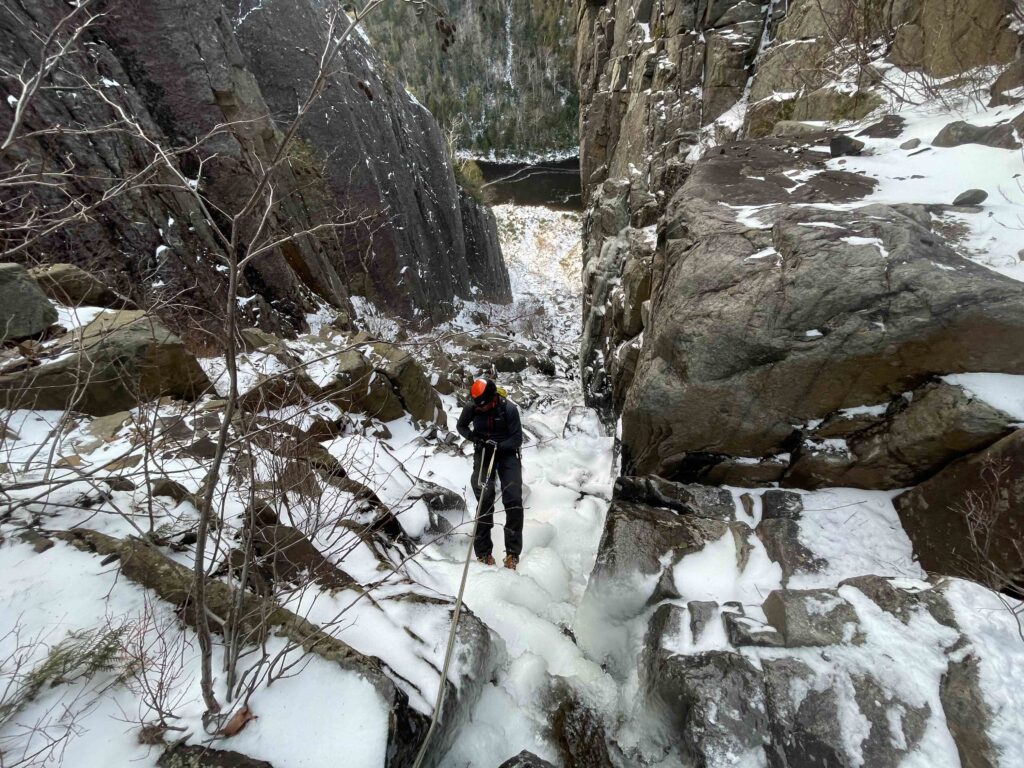
Phillip rappeled. Then, we descended out of the dike, back to the shores of Avalanche Lake. We unracked here and switched back to hiking mode to get back to our campsite.
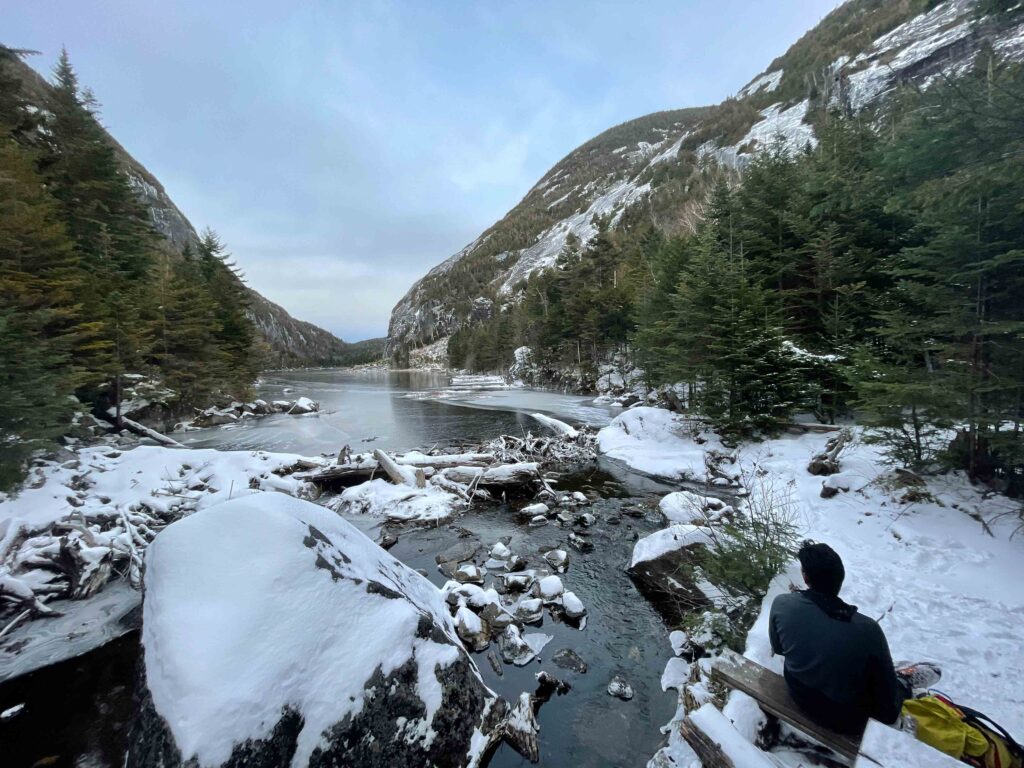
We returned after some more miserable hiking. Alas, we could now enjoy the luxuries that caused our excessive suffering. We ate cheesecake, drank beer, and had warm food. We sat at Colden dam, watching more ice form on the lake with the cold temperatures.
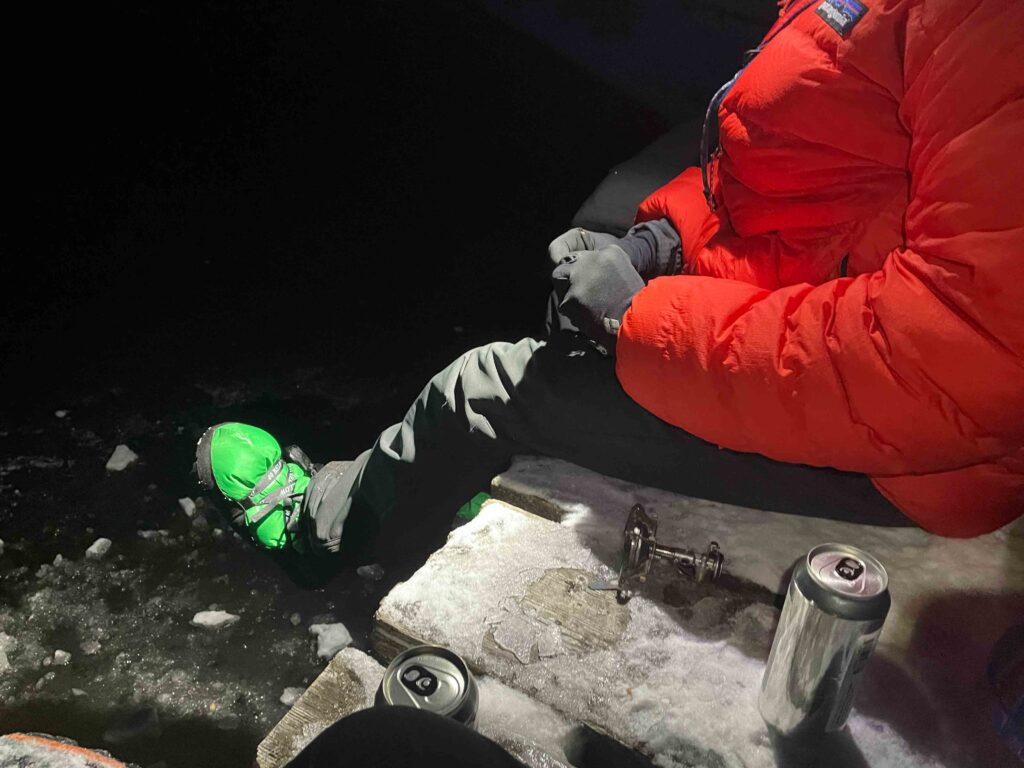
Around 8 p.m., four hours past dark, we went back to the tent. Phillip’s feet weren’t great, and they were starting to develop frostbite on the toes. As a backup plan, we planned to hike Marcy and Skylight tomorrow. We wouldn’t push it though with frost-bitten toes.
We woke up the next morning. Phillip’s feet felt better, but the toes were slightly discolored thanks to the frostbite. With below-freezing temperatures and the conditions, we wouldn’t push it. We decided to go back to the truck, but only after gorging the rest of our food.
While sipping coffee and eating fettucine alfredo at Colden Dam, a ranger stopped by and said hi to us. He lives at a ranger cabin on the west shore of the lake during the summer and fall. He said we were the first people he’d seen in a few days, and asked how the conditions in the Trap Dike were.
I wondered how he knew we went there, but he said he had stopped by the day before and saw our ice climbing gear. We were dead asleep from the approach, which is why we didn’t hear him.
He went off to patrol the Flowed Lands, and we packed up our campsite.
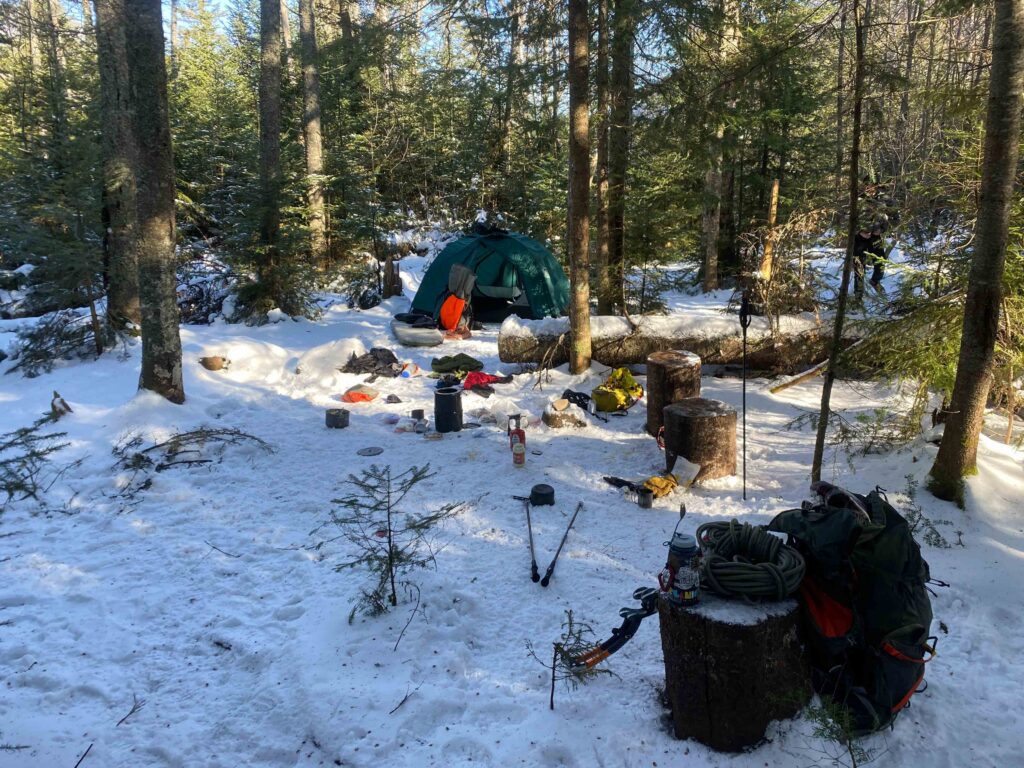
It turns out that the two pairs of boots I brought were helpful. Phillip used my mountaineering boots on the way back. They were waterproof and looser, helpful for his frostbitten toes.
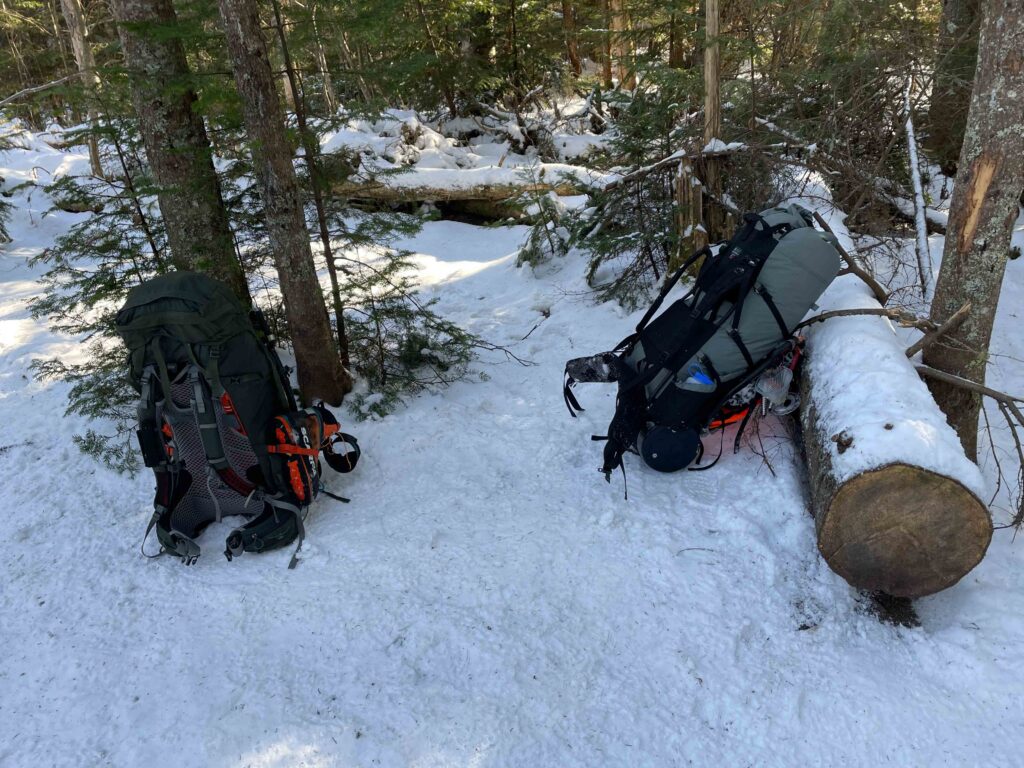
It was now warmer, and there was less ice on the way back. There was plenty of mud, but that was way easier to deal with. We spent a few minutes at Flowed Lands along the way, one of my favorite parts of the High Peaks.
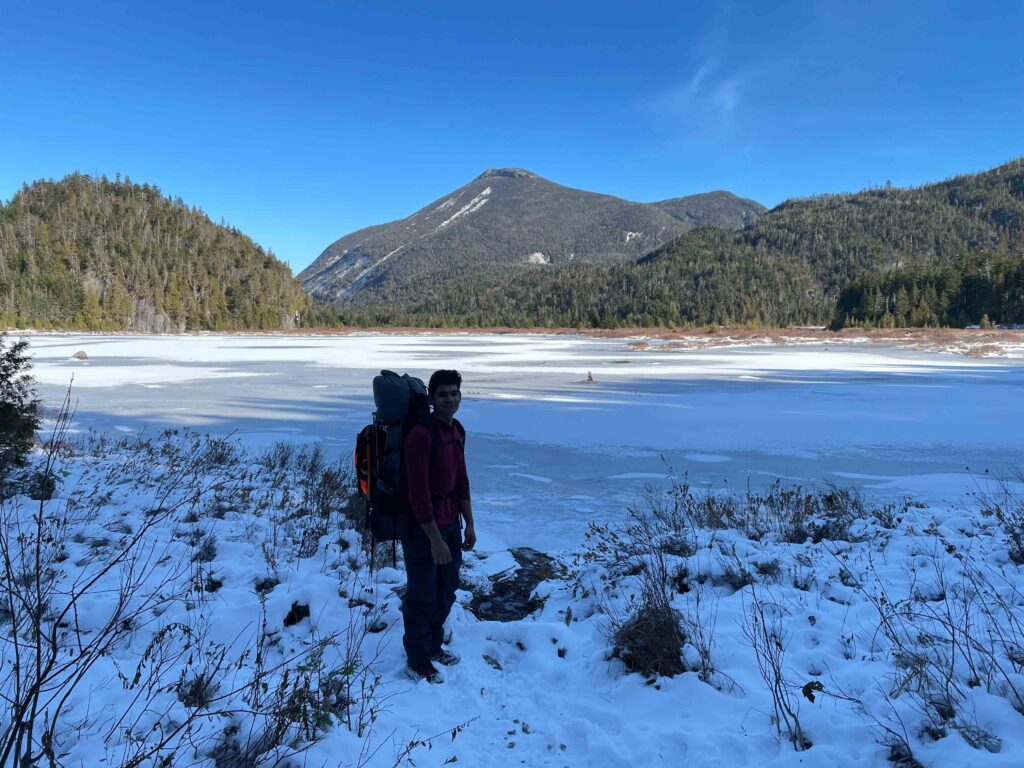
We made good time, reaching the truck in 2 hours from Colden Dam. We met some tourists at the trailhead checking out the nearby ghost town. We offered them the rest of our cheesecake — now very crushed — but they said no. Unfortunate, but understandable.
So, I ate that last slice of cheesecake, and we drove back to Boston.
